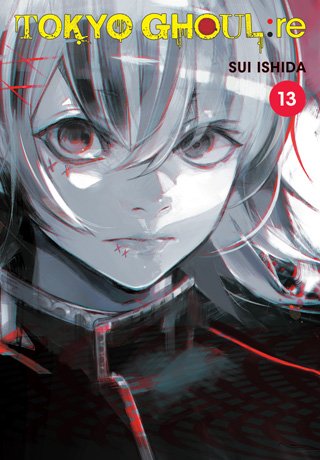Tokyo Ghoul: re Volume 13 Review
Please note that the following review contains major spoilers for the events of Volume 13.
Tokyo Ghoul: re is the sequel manga to Tokyo Ghoul, written by Sui Ishida. It’s a psychological action-thriller of sorts that explores the conflict between the flesh-consuming Ghouls of Tokyo and the CCG, an organisation whose main purpose is to exterminate Ghouls and keep the peace.
Tokyo Ghoul was given an anime adaptation back in 2014 and became quite popular, with a now somewhat infamous sequel that took a different route from the manga. The sequel series Tokyo Ghoul: re followed a similar pattern, though tried rushing through 121 chapters in its 12 episode second season instead. Thankfully, readers can experience the story in its original format, thanks to VIZ Media.
Volume 13 delivers a near constant on-the-edge read as an inquiry into Furuta’s integrity turns violent and Kaneki takes truly desperate measures to protect the ones he loves. The narrative focus frequently shifts between these two fights before ending with an unexpected bombshell that (without spoilers) not many would see coming.
The first conflict sees an unlikely alliance as Kuroiwa (senior) and Urie meet, having agreed to submit an inquiry into the actions of Bureau Chief Furuta. The situation quickly turns dire as Furuta brings out the clowns – specifically their founder Roma and the bizarre Shikorae. The fight is tense and bloody but also made infinitely cooler as a Quinque-less Kuroiwa improvises with a sword to take on his opponents.
The fight also finally gives readers some context as to who Roma is. Despite Roma having founded the clowns, we know very little about the character and Ishida gives us a glimpse into the reasoning behind the clowns and who they are, yet never gives too much away.
The aftermath of the inquiry is shocking but equally unpredictable when a familiar face arrives to take down Furuta and reveal his Ghoul lineage. It’s hard not to lean into spoiler territory but let’s just say that the unexpected return of Marude and his men is overshadowed considerably by a recurring character revealing his true identity to Urie.
Roughly six hours after the Inquiry and on the Ghouls’ side of the story, key players Kaneki, Tsukiyama, Nishiki and Banjou are busy scouting for food supplies when Kaneki senses that something is amiss. His hunch is correct as Furuta has sent an army of CCG members, including Mutsuki and their army of Oggai, to exterminate all living Ghouls underground.
Touka, Hinami, Yomo, Miza and Naki’s White Suits do their best to offset the army of ruthless ruffians but the battle feels hopelessly one-sided. There is a real weight to the proceedings as several characters volunteer to sacrifice themselves to save those who can’t fight back – especially the remaining Ghoul children.
Yomo, still wracked with guilt over failing to protect his sister – Touka’s mother – holds off Mutsuki and Aura whilst Hirako and the O Squad have to deal with threats from both sides – namely an escapee Hajime and a vengeful Koori Ui.
All of this culminates in Kaneki returning to the base just as Hinami prepares to make her own sacrifice against the deadly pairing of Suzuya and Abara, each one armed in full-body Kokaku (protective armor made from a Quinque).
Their showdown is cut short, however, and not by outside interference but by artistic intent. Ishida skips this battle entirely and shifts the narrative ahead to the aftermath. Said aftermath is a limbless and bloody Kaneki lying on the ground, trying to perceive his loss as both Futura and Najime appear before him. Furuta declares that Kaneki has lost and Najime brings him gifts too gruesome to describe.
Once more we are treated to a glimpse inside Kaneki’s psyche – a recurring narrative trait throughout Tokyo Ghoul and key to better understanding our conflicted protagonist.
The volume ends on a cliffhanger as Kaneki, with no other option, launches a final counterattack that literally sends ripples across Tokyo and Furuta declares that he has won.
I was again impressed with some of the development for certain characters. The unlikely pairing of Urie and Kuroiwa, seen fighting together and coming to an understanding regarding the fate of Urie’s father made the battle all that more eventful.
This ties into the character sacrifices as throughout Volume 23 key players put their lives on the line for the ones they love. Whether it be Hinami, Naki, Yomo or Kaneki it’s an uphill struggle that rarely ends in success, and there’s no sense of victory at all.
Ishida is an artist whose work, even when imperfect, maintains a unique style that captures the essence of the narrative and characters. Little moments and facial expressions really add to a scene and some inspired choices lend that bit more memorability.
This is especially prevalent at the end of Chapter 143, wherein Ishida subverts expectations and adds upon it as Kaneki lies utterly vanquished and in #144 wherein we get a parody of shonen-style battle tournaments.
What stuck with me the most was the imagery of Furuta walking away with smiley faces being plastered all over the page and the words “GAME OVER” looming over. It left me waiting for a week that felt like forever.
The translation was carried out by Joe Yamazaki who once again does a solid job of conveying the dialogue and sound effects. I also appreciate that they’ve been translating the omake as they’re very funny.
Overall, Tokyo Ghoul: re Volume 13 builds upon the conflicts and tension that had been building since Kaneki defeated Arima and Furuta became Bureau Chief. Unlike Tokyo Ghoul, wherein Chapter 143 and its poignant ending offered a glimmer of hope, all there is here is a sense of loss and impending devastation.


